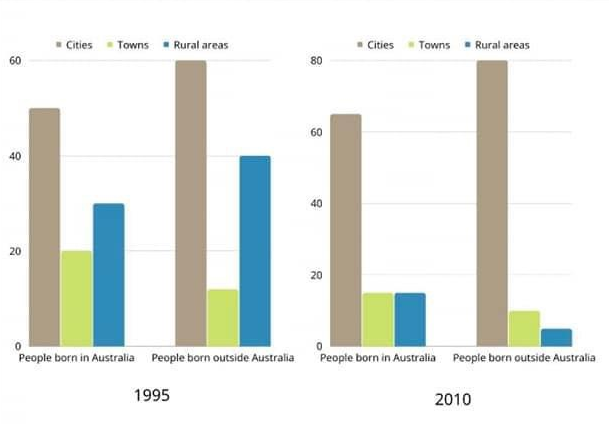[Shwetank S] Writing Practice Test 1007209
Task 1
You should spend about 20 minutes on this task.
The bar chart below describes some changes about the percentage of people were born in Australia and who were born outside Australia living in urban, rural and town between 1995 and 2010.
Summarise the information by selecting and reporting the main features and make comparisons where relevant.
You should write at least 150 words.

The two charts represented here showcase the story about the migration patterns of the Australia from 1995 upto 2010. In the 90s, it was clear that most of the people born in Australia were living mostly in cities and rural areaas. The gap between the town and rural populations for this demographic wasnt too big, showcasing that it was spread quite evenly. Comparing this with people born outside Australia it is evident that most prefered to either live in cities or rural areas. Showcasing that most of the opportunities for work were available in either cities or the small communities in rural parts.
The second graph here tells us how the migration pattern changed over the the fifteen years in between. For the people that were born in the country the amount living in rural parts came down significantly. Similar trend was also seen for the native populations of towns. All this makes it clear that over the years the opportunity loss in towns and villages have caused the native born Australians to migrate to cities. The trend seems even more extreme in the immigrant populace, where the rural component has came down even lower than the town percentage. Evidently, most of them prefer living in cities as the opportunity effect is even more extreme for new immigrants,
Task 2
You should spend about 40 minutes on this task.
Rich countries often give money to poorer countries, but it does not solve poverty. Therefore, developed countries should give other types of help to the poor countries rather than financial aid. To what extent do you agree or disagree?
You should write at least 250 words.
I am in agreement with the statemet posed here. Most of the rich countries of the world allocated a certain portion of their GDPs as foreign aid. This, however, doesnt seem to be making any sort of changes when it comes to poverty in the developiing nations. The main reason for this is that throwing money at a problem itself wont make that problem go away. We need multi faceted approach to deal with a social issue as big as poverty. More focus should be on the factors that cause the huge sections of the populations in these countries to live impoverished lives. Things like corruption, government neglect, tensions between minorities and majority, improper usage of the natural resources etc can be major contributors of inhibiting economic upward movement for people of a nation. Money by itself in these situations can even exacerbate the issues, like a corrupt government just misusing the funds provided.
I personally prefer when there is a collaborative effort between the developed and developing countries based on knowledge sharing. Knowledge is power. Empowering the people of a developing nation by creating institutions of knowledge like school or institues of higher education can bring a lot of benefits for the nation as a whole. Having an educated workforce is a strong positive trait that can kickstart and push the economy of a budding nation to new heights. Creating collaboration between industries in order to bring better technologies to impoverished countries can help tremendously in terms of growing crucial sectors of their industries. This in turn would lead to better employment for all.
A well educated workforce that has industries to harness its talents would always be better than just some percentage of GDP assigned as foreign aid. For the help to work, the govenrments of the developed nations would have to gets theirs hands dirty in solving the issues at ground level.
Community’s feedback
Sorry! We couldn't find any contents.
Leaderboard:
| # | User | Score | Time | |
|---|---|---|---|---|
| Kento Nanami |  | 8.5 | 52:31 | |
| Nayef Alhajraf |  | 8.5 | 60:00 | |
| Ella Ruppo |  | 7.5 | 59:39 | |
| 4 | chengxi yu |  | 7.0 | 00:00 |
| 5 | avin chui |  | 7.0 | 59:11 |
| 6 | 癫 火 |  | 7.0 | 59:51 |
| 7 | Li Xuefeng |  | 6.5 | 03:46 |
| 8 | Chanisara Wongkongsang |  | 6.5 | 56:37 |
| 9 | Dan H |  | 6.0 | 50:41 |
| 10 | Carlo Di Giacomo |  | 6.0 | 60:00 |



